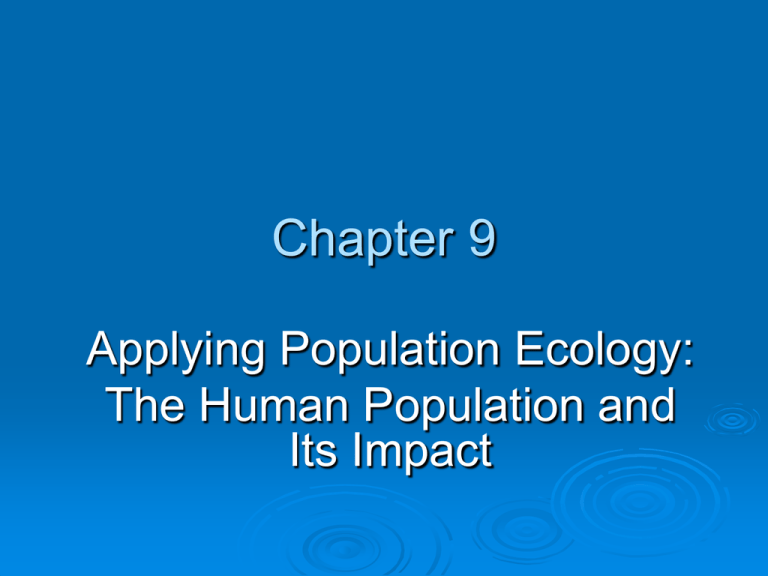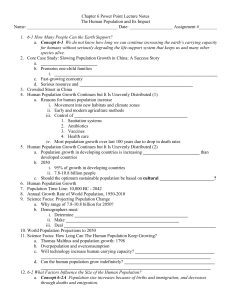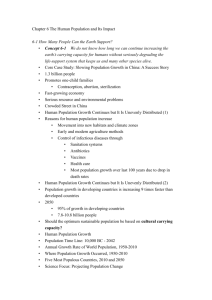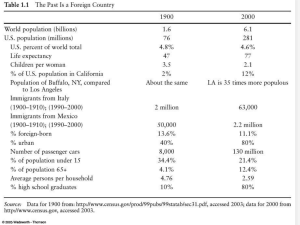Ch. 9: Applying Population Ecology
advertisement

Chapter 9 Applying Population Ecology: The Human Population and Its Impact Chapter Overview Questions What is the history of human population growth, and how many people are likely to be here by 2050? How is population size affected by birth, death, fertility, and migration rates? How is population size affected by percentages of males and females at each age level? How can we slow population growth? Chapter Overview Questions (cont’d) What success have India and China had in slowing population growth? What are the major impacts of human activities on the world’s natural ecosystems? Updates Online The latest references for topics covered in this section can be found at the book companion website. Log in to the book’s e-resources page at www.thomsonedu.com to access InfoTrac articles. InfoTrac: Fewer girls, and few in Indian village will discuss why. Chicago Tribune, May 16, 2006. InfoTrac: Immigration Math: It's a Long Story. Daniel Altman. The New York Times, June 18, 2006 pBU4(L). InfoTrac: Status quo equals immigration woe. The Christian Science Monitor, April 17, 2006 p17. PBS: Voices of Concern: Paul Hewitt NRP: American-Born Hispanic Population Rising Population Reference Bureau: China’s Concern Over Population Aging and Health Core Case Study: Is the World Overpopulated? The world’s population is projected to increase from 6.6 billion to 8.9 billion between 2006 and 2050. The debate over interactions among population growth, economic growth, politics, and moral beliefs is one of the most important and controversial issues in environmental science. Core Case Study: Is the World Overpopulated? Much of the world’s population growth occurs in developing countries like China and India. Figure 9-1 Core Case Study: Is the World Overpopulated? Some argue that the planet has too many people. Some feel that the world can support billions of more people due to technological advances. There is a constant debate over the need to reduce population growth. Must consider moral, religious, and personal freedom. HUMAN POPULATION GROWTH: A BRIEF HISTORY The human population has grown rapidly because of the expansion of agriculture and industrial production and lower death rates from improvements in hygiene and medicine. In 2006, the population of developed countries grew exponentially at 0.1% per year. Developing countries grew (15 times faster at 1.5% per year. Where Are We Headed? We do not know how long we can continue increasing the earth’s carrying capacity for humans. There are likely to be between 7.2-10.6 billion people on earth by 2050. 97% of growth in developing countries living in acute poverty. What is the optimum sustainable population of the earth based on the cultural carrying capacity? Where Are We Headed? U.N. world population projection based on women having an average of 2.5 (high), 2.0 (medium), or 1.5 (low) children. Figure 9-2 FACTORS AFFECTING HUMAN POPULATION SIZE Population increases because of births and immigration and decreases through deaths and emigration. Instead of using raw numbers, crude birth rates and crude death rates are used (based on total number of births or deaths per 1,000 people in a population). FACTORS AFFECTING HUMAN POPULATION SIZE Average crude and birth rates for various groupings of countries in 2006. Figure 9-3 FACTORS AFFECTING HUMAN POPULATION SIZE The world’s 10 most populous countries in 2006 with projections in 2025. Figure 9-4 Declining Fertility Rates: Fewer Babies per Women The average number of children that a woman bears has dropped sharply. This decline is not low enough to stabilize the world’s population in the near future. Replacement-level fertility: the number of children a couple must bear to replace themselves. Total fertility rate (TFR): the average number of children a woman has during her reproductive years. Declining Fertility Rates: Fewer Babies per Women The replacement level to sustain a population is 2.0 children. In 2006, the average global Total Fertility Rate was 2.7 children per woman. 1.6 in developed countries (down from 2.5 in 1950). 3.0 in developing countries (down from 6.5 in 1950). Case Study: Fertility and Birth Rates in the United States Nearly 2.9 million people were added to the U.S. in 2006: 59% occurred because of births outnumbering deaths. 41% came from illegal and legal immigration. Case Study: Fertility and Birth Rates in the United States In 2006, the total fertility rate in the United States was slightly > 2.0 Figure 9-5 Case Study: Fertility and Birth Rates in the United States The baby bust that followed the baby boom was largely due to delayed marriage, contraception, and abortion. Figure 9-6 47 years Life expectancy 77 years 8% Married women working outside the home 81% 15% High school graduates 83% 10% Homes with flush toilets Homes with electricity Living in suburbs Hourly manufacturing job wage (adjusted for inflation) Homicides per 100,000 people 98% 2% 99% 10% 52% 1900 $3 2000 $15 1.2 5.8 Fig. 9-7, p. 176 Factors Affecting Birth Rates and Fertility Rates The number of children women have is affected by: The cost of raising and educating them. Availability of pensions. Urbanization. Education and employment opportunities. Infant deaths. Marriage age. Availability of contraception and abortion. Factors Affecting Death Rates Death rates have declined because of: Increased food supplies, better nutrition. Advances in medicine. Improved sanitation and personal hygiene. Safer water supplies. U.S. infant mortality is higher than it could be (ranked 46th world-wide) due to: Inadequate pre- and post-natal care for poor. Drug addiction. High teenage birth rate. Case Study: U.S. Immigration Since 1820, the U.S. has admitted almost twice as many immigrants and refugees as all other countries combined. Figure 9-8 POPULATION AGE STRUCTURE The number of people in young, middle, and older age groups determines how fast populations grow or decline. The number of people younger than age 15 is the major factor determining a country’s population growth. Changes in the distribution of a country’s age groups have long-lasting economic and social impacts. POPULATION AGE STRUCTURE Populations with a large proportion of its people in the preproductive ages 1-14 have a large potential for rapid population growth. Figure 9-9 POPULATION AGE STRUCTURE 32% of the people in developing countries were under 15 years old in 2006 versus only 17% in developed countries. Figure 9-10 POPULATION AGE STRUCTURE Today, baby boomers make up nearly half of all adult Americans and dominate the populations demand for goods and services. Figure 9-11 Animation: U.S. Age Structure PLAY ANIMATION POPULATION AGE STRUCTURE About 14% of the world’s population live in countries with stabilizing or declining populations. Rapid population decline can lead to longlasting economic and social problems. Death from AIDS can disrupt a country’s social and economic structure by removing significant numbers of young adults. Global again may help promote peace. POPULATION AGE STRUCTURE Age structure predictions based on a medium fertility projection. The cost of an aging population will strain the global economy. Figure 9-12 POPULATION AGE STRUCTURE Some problems with rapid population decline. Which of these problems do you believe are the most important? Figure 9-13 SOLUTIONS: INFLUENCING POPULATION SIZE Demographic Transition: As countries become economically developed, their birth and death rates tend to decline. Preindustrial stage: little population growth due to high infant mortality. Transitional stage: industrialization begins, death rates drops and birth rates remain high. Industrial stage: birth rate drops and approaches death rate. SOLUTIONS: INFLUENCING POPULATION SIZE Generalized model of demographic transition. Some developing countries may have difficulty making the demographic transition. Figure 9-14 SOLUTIONS: INFLUENCING POPULATION SIZE Family planning has been a major factor in reducing the number of births and abortions throughout most of the world. Women tend to have fewer children if they are: Educated. Hold a paying job outside the home. Do not have their human right suppressed. SOLUTIONS: INFLUENCING POPULATION SIZE The best way to slow population growth is a combination of: Investing in family planning. Reducing poverty. Elevating the status of women. SLOWING POPULATION GROWTH IN INDIA AND CHINA For more than five decades, India has tried to control its population growth with only modest success. Since 1970, China has used a governmentenforced program to cut its birth rate in half and sharply reduce its fertility rate. Percentage of world population Population 20% 1.1 billion 1.3 billion 1.4 billion 1.6 billion Population (2050) (estimated) Illiteracy (% of adults) Total fertility rate Infant mortality rate 47% 17% 36% Population under age 15 (%) Population growth rate (%) 20% 1.6% 0.6% 2.9 children per women (down from 5.3 in 1970) 1.6 children per women (down from 5.7 in 1972) 58 27 62 years 70 years Life expectancy Percentage living below $2 per day GDP PPP per capita India China 17% 80 47 $3,120 $5,890 Fig. 9-15, p. 186 India’s Failed Family Planning Program Poor planning. Bureaucratic inefficiency. Low status of women. Extreme poverty. Lack of administrative financial support. Disagreement over the best ways to slow population growth. China’s Family Planning Program Currently, China’s TFR is 1.6 children per women. China has moved 300 million people out of poverty. Problems: Strong male preference leads to gender imbalance. Average population age is increasing. Not enough resource to support population. HUMAN ASPECTS ON NATURAL SYSTEMS Excluding Antarctica, human activities have affect about 83% of the earths land surface. Figure 9-16 HUMAN ASPECTS ON NATURAL SYSTEMS We have used technology to alter much of the rest of nature in ways that threaten the survival of many other species and could reduce the quality of life for our own species. Figure 9-17











